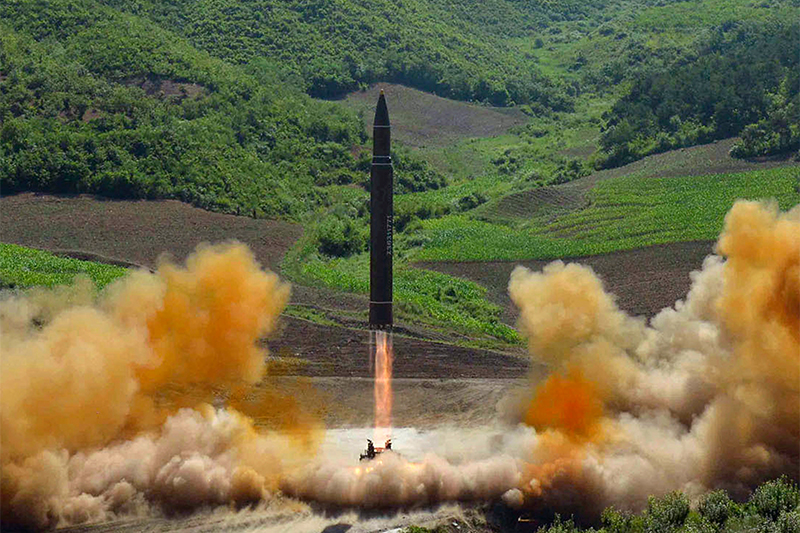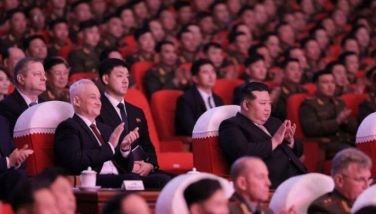North Korea still mastering how to deliver a nuke to US

This file photo distributed by the North Korean government shows what was said to be the launch of a Hwasong-14 intercontinental ballistic missile, ICBM, in North Korea's northwest, Tuesday, July 4, 2017. Independent journalists were not given access to cover the event depicted in this photo. The strongest U.N. sanctions in a generation may still prove no match for North Korea’s relentless nuclear weapons ambitions. Even in diplomatic triumph, the Trump administration is gambling that it has enough time to test if economic pressure can get Kim Jong Un’s totalitarian government to end its missile advances and atomic weapons tests. Korean Central News Agency/Korea News Service via AP, File
WASHINGTON — No need to duck and cover just yet. While U.S. intelligence officials are pretty sure North Korea can put a nuclear warhead on an intercontinental missile that could reach the United States, experts aren't convinced the bomb could survive the flight to America.
They cite lingering questions about Kim Jong Un's nuclear know-how. Could North Korea deploy nuclear weapons successfully time after time and hit their intended targets? Would its weapon system break apart from the heat and stress it would sustain as it re-enters the Earth's atmosphere at roughly 10 times faster than a speeding bullet?
"I don't think North Korea has a good measure of how accurate the missile is at this point," said Michael Elleman, an expert with the International Institute for Strategic Studies. "They don't know if the re-entry technologies will really hold up — whether the bomb will survive the trip."
North Korea has short-range missiles that can hit its neighbors. It has tested an intermediate one that could strike Guam, a U.S. territory, as well as a longer-range missile that could reach Hawaii and perhaps the West Coast of the United States. The intermediate and long-range missiles are still being developed and it's still questionable if they can reliably strike targets.
Kim must do more tests to master what is known as "re-entry" in missile parlance, experts believe. The process involves shielding a nuclear warhead from the high temperatures and force it faces when it re-enters the Earth's atmosphere at about 15,500 mph (7 kilometers a second).
"In principle, Kim Jong Un could hit the United States with a nuclear weapon," said Elleman, a former scientist at Lockheed Martin's Research and Development Laboratory who also worked as missile expert for U.N. weapons inspection missions. "In practice, I think they are probably a half-year to a full year away from having something that will work more often than it would fail."
Joseph Bermudez Jr., an internationally recognized expert on North Korean defense and intelligence affairs and ballistic missile development, agrees.
"Putting these things all together and making them work is extremely challenging, and they haven't yet demonstrated a capability to produce a reliable re-entry vehicle, which is what houses the actual nuclear device," he said. "Remember, they've only tested these systems very few times."
Still, Bermudez, said, North Korea is "on track" to figure it out.
U.S. officials also think it's just a matter of time before Kim's program fully matures.
National Intelligence Director Dan Coats told Congress in May that Kim has been photographed beside a nuclear warhead design and missile airframes to show that North Korea has warheads small enough to fit on a missile.
That same month, Lt. Gen Vincent Stewart, the Defense Intelligence Agency director, told lawmakers that while Kim must still work on the technical aspects of re-entry, it's only a "matter of enough trial and error to make that work. They understand the physics, so it's just a matter of design."
Coats and Stewart testified before North Korea conducted its first test of an intercontinental missile on July 4. On July 28, it conducted a second test of its long-range Hwasong-14 ICBM.
The second test flight was captured by a rooftop camera operated by Japan's NHK television on the northern island of Hokkaido. Elleman, who analyzed the video, concluded that it most likely "disintegrated" before splashdown, suggesting North Korea is still struggling with re-entry.
"I think it probably failed fairly late in the process," said John Schilling, a consultant with 38 North, a respected website on North Korea at Johns Hopkins University's School of Advanced International Studies.
Schilling said the success of North Korean missiles also depend on the weight of the payload. That's the weight of the nuclear weapon plus its heat-shielding re-entry system. North Korea is able to make one that weighs between 1,100 and 1,300 pounds, or between 500 and 600 kilograms. One that size might reach West Coast targets, Schilling said. But North Korea would need to make one lighter to strike farther east.
"It needs to be light in order to achieve range, but it also needs to be built fairly tough to survive, and those two things are at odds with one another," Schilling said. "Too light is a problem in that the payload would be too fragile and won't survive the trip, particularly atmospheric re-entry at the far end."
For now, North Korean missile development is advancing along amid extremely grave threats from both Pyongyang and Washington.
On Tuesday, a news report said North Korea could now wed nuclear warheads with its missiles, including its longest-range ones that might be able to hit the continental United States. The nuclear advances were detailed in an official Japanese assessment and in a story by The Washington Post that cited U.S. intelligence officials and a confidential Defense Intelligence Agency report.
President Donald Trump is warning North Korea not to make any more threats or face "fire and fury like the world has never seen."
North Korea then announced a detailed plan to launch missiles toward the U.S. Pacific territory of Guam, a major military hub and home to U.S. bombers.
On Friday, Trump tweeted: "Military solutions are now fully in place, locked and loaded, should North Korea act unwisely."
- Latest
- Trending































